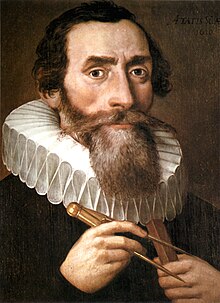
Summary
Die Harmonie der Welt (The Harmony of the World) is an opera in five acts by Paul Hindemith. The German libretto was by the composer.
| Die Harmonie der Welt | |
|---|---|
| Opera by Paul Hindemith | |
 Johannes Kepler, whose work inspired the opera and its title | |
| Translation | The Harmony of the World |
| Librettist | Hindemith |
| Language | German |
| Based on | Kepler's Harmonices Mundi |
| Premiere | 11 August 1957 Prinzregententheater, Munich |
The title of the opera is taken from Harmonices Mundi by the astronomer Johannes Kepler (1571–1630) who is the subject of the opera. Hindemith used the planetary system as a metaphor for his own musical arrangement of the chromatic scale.
The opera was completed in May 1957. Hindemith had previously composed a symphony of the same name in 1951.[1]
Performance history edit
It was first performed on 11 August 1957, at the Prinzregententheater, Munich, conducted by the composer.[2]
A truncated monaural recording of the opera appeared on the Stradivarius label, but a complete recording of the work had to wait until the digital era, when Marek Janowski conducted the entire opera for the Wergo label (see section Recordings).
Due to Kepler's association with his home town of Linz, Austria, performances of the opera were scheduled at the Landestheater Linz beginning on April 8, 2017, and continued for several performances into June, 2017. The Bruckner Orchestra Linz was conducted by Gerrit Prießnitz.[3] [4]
Roles edit
| Role | Voice type | Premiere cast, 11 August 1957[5] Conductor: Paul Hindemith |
|---|---|---|
| Susanna, Kepler's wife/Venus | soprano | Liselotte Fölser |
| Young Susanna, Kepler's daughter | soprano | |
| Katharina, Kepler's mother/Moon | contralto | Hertha Töpper |
| Wallenstein, warlord/Jupiter | tenor | Richard Holm |
| Ulrich Grüßer, Kepler's pupil/Mars | tenor | K. Wehofschlitz |
| Christoph Kepler | tenor | |
| Johannes Kepler, the astronomer/Earth | baritone | Josef Metternich |
| Emperor Rudolf II/Emperor Ferdinand II/Sun | bass | Kieth Engen |
| Daniel Hizler, priest/Mercury | bass | Joseph Knapp |
| Tansur, astrologer/Saturn | bass | Marcel Cordes |
| Baron Starhemberg | baritone | |
| Richter | baritone |
Synopsis edit
Set in the 17th century, the opera is the story of the search for universal harmony by the astronomer Johannes Kepler.
Orchestra edit
Two flutes, three oboes, three clarinets, three bassoons, four horns, two trumpets, four trombones, a timpani, a drum kit, a harp and 40 strings. Seven woodwinds, four brass instruments, three strings and a drum kit are needed for the stage music.
Music edit
Particular highlights of the work are the depiction of the witch trial with the dogged intensity of the choirs, the Electoral Diet in Regensburg and the final scene: the work ends in a large-scale passacaglia in radiant E major. The music seems baroque and modern at the same time.
Recordings edit
In 2002 WERGO released the world premiere recording as part of their Paul Hindemith Edition. This recording was made in the Jesus-Christus-Kirche in Berlin-Dahlem in February/March 2000, with Marek Janowski conducting the Berlin Radio Symphony Orchestra, and François Le Roux in the role of Johannes Kepler.[6][7]
References edit
- ^ "Opera Die Harmonie der Welt". Fondation Hindemith. Retrieved 24 February 2019.
- ^ "Die Harmonie der Welt". Schott Music. Archived from the original on 1 February 2013. Retrieved 5 November 2012.
- ^ Peter Jungblut (10 April 2017). "Kritik - Hindemiths Harmonie der Welt in Linz – Intellektueller Kraftakt". BR Klassík. Retrieved 9 December 2019.
- ^ Petra und Helmut Huber (9 April 2017). "Linz/ Musiktheater: Die Harmonie der Welt von Paul Hindemith. Premiere". Online Merker. Retrieved 9 December 2017.
- ^ Casaglia, Gherardo (2005). "Die Harmonie der Welt, 11 August 1957". L'Almanacco di Gherardo Casaglia (in Italian).
- ^ "On-line catalogue entry – Paul Hindemith – Die Harmonie der Welt". WERGO. Retrieved 30 September 2010.
- ^ "Review – Hindemith – Die Harmonie der Welt". MusicWeb International (Paul Shoemaker). September 2003. Retrieved 30 September 2010.
Further reading edit
- Skelton, Geoffrey (1992), 'Harmonie der Welt, Die' in The New Grove Dictionary of Opera, volume 2, page 647; ed. Stanley Sadie (London) ISBN 0-333-73432-7.
External links edit
- Die Harmonie der Welt (opera): Scores at the International Music Score Library Project


